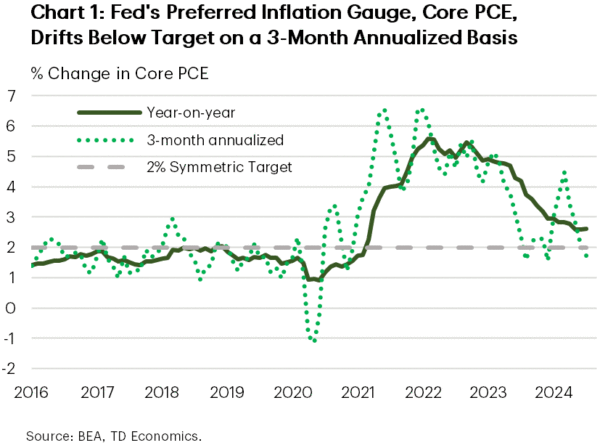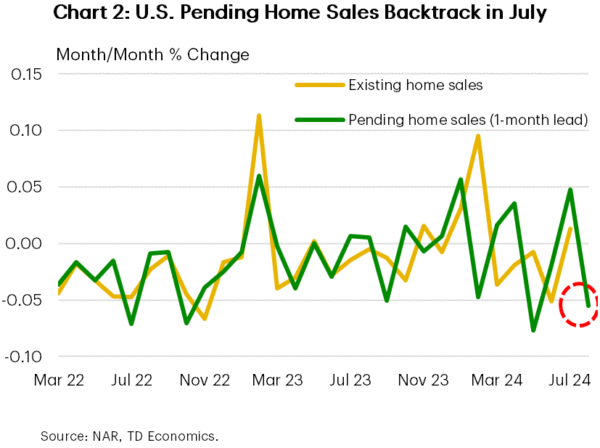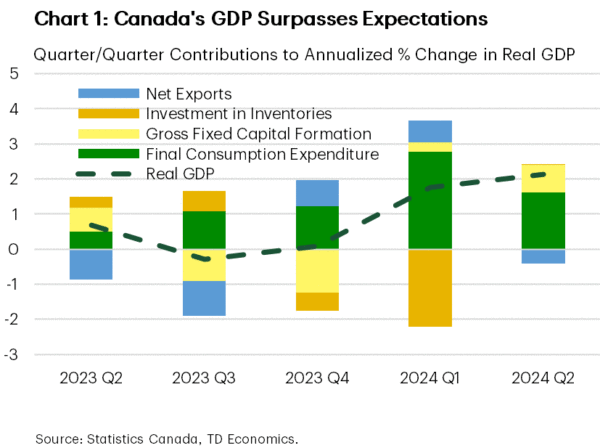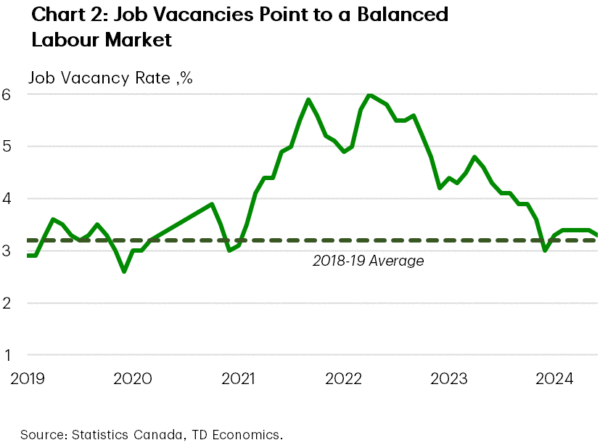U.S. Highlights
- The second estimate of Q2 GDP revealed that the U.S. economy grew at 3.0% annualized, a bit stronger than previously reported, thanks to an upward revision in consumer spending.
- Spending momentum continued into July, outstripping income growth for the sixth consecutive month and pushing the savings rate to a two-year low of 2.9%.
- Core PCE inflation held steady at 2.6% year-on-year in July, while the three-month annualized rate of change fell below the Fed’s 2% inflation target.
Canadian Highlights
- Second-quarter GDP came in ahead of expectations, driven by government expenditures and business spending. Other details were less encouraging, as household spending, residential investment and net exports fell short of expectations.
- In other news, June payrolls declined for the first time in six months while the job vacancy rate remained steady.
- The Bank of Canada is likely to interpret this week’s data as supportive of maintaining its easing bias, with three more quarter-point cuts expected by year-end.
U.S. – Fed to Tilt Focus to Labor Market as it Tees Up First Rate Cut
The Labor Day weekend is upon us, providing an opportunity to celebrate the achievements of the American worker. Keeping with the labor market theme, now that the Fed appears relatively confident that inflation will return to target, we believe it will put a little more emphasis the other side of its dual mandate – the goal of maximum employment – to determine the speed and size of policy easing. In that vein, next week’s payrolls report can’t come soon enough. This week’s data, meanwhile, did little to rock the boat, coming in broadly positive. Amidst this backdrop, long-term yields trended modestly higher, while the S&P 500 looks to end the week lower by 0.6% as of the time of writing.
A second read on U.S. GDP revealed an even better growth profile of 3.0% annualized in the second quarter (vs. 2.8% previously), thanks in large part to an upward revision in consumer spending (2.9% vs. 2.3% previously). But this week’s highlight was the July personal income and spending (PCE) report. The latter showed that overall and core PCE inflation held steady on an annual basis, coming in at respectively 2.5% and 2.6% in July. Looking to more recent trends, on a 3-month annualized basis, core PCE eased to 1.7% in July from 2.1% in the month prior, suggesting we’re likely to see more cooling in inflationary pressures in the months ahead (Chart 1).
The PCE report also shed light on consumer spending, which had a relatively healthy start to the third quarter. Real spending rose by 0.4% month-over-month (m/m) in July – an acceleration from 0.3% in the month prior, with both goods and service spending chipping in with healthy gains. However, real disposable personal income continued to trail behind (+0.1%), which meant consumers had to dip into their savings to sustain the higher rate of spending. As a result, the personal savings rate fell to a two-year low of 2.9%.
Other consumer-related indicators continued to paint a nuanced picture. Americans were a little more upbeat in August, with the Conference Board confidence measure rising to a six-month high, thanks in large part to an improvement in the “expectations” subcomponent. Still, plans to buy large ticket items, including cars, homes, and major appliances, all trended lower on the month. And it’s not just survey data showing a consumer’s reluctance to make big purchases. Pending home sales – a leading indicator for existing home sales – fell sharply in July (-5.5%), driving home the point that the recent pullback in interest rates has so far failed to spark a sustained improvement in sales (Chart 2).
Next week, attention will turn towards the August payrolls report, which will help shape whether the Fed cuts by 25 or 50 basis points at its next rate decision in September. Market expectations call for some rebound in job gains relative to July’s gain of 114,000. The recent steadying of both jobless claims and job postings suggests that the chances of another downside miss is less likely, which favors a 25 basis point cut in September.
Canada – More Reason to Ride Down the Policy Escalator
The final week of a summer break stayed drama-free with analysts’ attention squarely on Friday’s marquee release of Canada’s second-quarter GDP. Equity markets saw intraday volatility primarily driven by earnings, leaving the TSX closing -0.3% on the week. In the rates market, today’s data was met as a confirmation of what had already been priced – a gradual stepwise descent in 25 basis points increments through the end of the year. Longer-term yields inched higher with the 10-year government bond up 8 bps to 3.12% to end the week.
Real gross domestic product (GDP) rose by 2.1% quarter-on-quarter (q/q, annualized) in the second quarter, ahead of expectations calling for a gain of 1.6% q/q (Chart 1). The primary drivers of this gain were government expenditures supported by increases in compensation of employees (expense on the government ledger), and purchases of goods and services. Business spending on non-residential investment and machinery & equipment also made a significant contribution to today’s reading.
However, other details were less encouraging. Household spending came in lower than expected, consistent with the more recent data pointing to a weaker trajectory. A higher revision to Q1 spending partially offsets last quarter’s miss as the upward adjustment roughly matches the magnitude of Q2’s shortfall. Services spending remained a steady growth contributor with consumers increasing their outlays on necessities such as housing, food, and electricity. Spending on goods edged down, particularly in automobile expenditures, which were impacted by temporary technological setbacks are expected to reverse next quarter. Softer spending combined with solid gains in compensation led to an increase in the savings rate, which rose to 7.2% – the highest reading since Q1 2022 and significantly above the pre-pandemic average.
On the housing front, residential investment saw its largest decline in over a year with all major components – construction, renovations and homeownership transfer costs – falling during the quarter. Net exports also fell short of expectations for a rebound, weighing on the GDP reading. We expect growth to continue at a below-trend pace for the next several quarters until the economy gains further relief from lower rates.
In other news, this week’s Survey of Employment, payrolls and hours data showed that June payrolls declined for the first time in six months. The job vacancy rate – a ratio of vacancies to a number of available jobs – remained close to its pre-pandemic average, indicating a relatively balanced demand-supply position (Chart 2). The details show significant disparities among sectors, with labour demand still elevated in the service sector, but has cooled below pre-pandemic levels for the goods-producing sector.
The Bank of Canada is likely to interpret this week’s data as supportive of maintaining its easing bias. With the Fed now poised to adopt a similar policy stance, the risk of significant monetary policy divergence has diminished, reducing downward pressure on the Canadian dollar and easing the risk of importing price inflation.
















